Yesterday, 22nd March, was the preview of Michelangelo Pistoletto’s exhibition “Da Cittadellarte alla Civiltà dell’Arte” at the Ducal Palace in Mantua. The opening ceremony was held in the Atrio degli Arcieri first, and then in the Loggia della Rustica, in the presence of all the protagonists of the exhibition and a large audience. After a series of institutional speeches, the guests were able to visit, for the first time, the rooms housing the works by the artist from Biella. The installations along the exhibition route, open until 12th June 2018, follow a narrative logic leading to the understanding of the research carried out by the artist in over 60 years of activity, from the first self-portraits to the mirror paintings and the Third Paradise, with particular attention to the creation and development of Cittadellarte, a place of gathering, thought and production for students and artists from all walks of life and nationalities. The exhibition will be open from Friday to Sunday, from 10.00 to 18.00, the entrance fee is € 10.
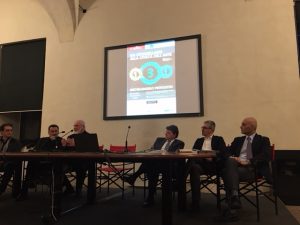
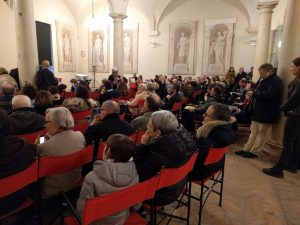
But let’s go back to the opening and into the details of the speeches of some of the speakers. Peter Assman (in charge of the critical curatorship of the exhibition) started saying: “We are experiencing a great artistic moment, almost magical. We are now celebrating in the centre of Mantua, in a complex dedicated to contemporary art: the most meaningful episodes in the history of the city and the Ducal Palace have always been linked to contemporaneity. And here we have Pistoletto and his exhibition: an Italian world artist, a perfect fit for our artistic context. ‘Da Cittadellarte alla Civiltà dell’Arte’ is much more than a mere exhibition…”
These words were echoed by the enthusiasm of Gianfranco Ferlisi, an official of the Ducal Palace: “For us, hosting Pistoletto’s exhibition is a great achievement, he is a man who’s made history in the second half of the 20th century and in the whole history of art. The Ducal Palace is going through a very important moment.”
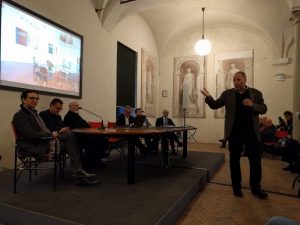
(In the picture, standing: Peter Assman)
Moving on to the speakers from Cittadellarte, the first to take the floor was Paolo Naldini, its director: “In 2000, when I joined Michelangelo in creating Cittadellarte, Pistoletto explained to me the origin of its name: on one hand a “citadel”, a reference to a defence, a closure; on the other a “city”, making us think of an opening instead. I added a semantic level from the same root: civitas, which, in Latin, means both civilization and citizenship. The citizenship is a permit to enter the civilization of art, but how do you obtain it? From the ius soli or ius sanguinis, here is the ius artist, based on the identification of total freedom and responsibility. What entitles you to this permit? How do you become a citizen of Cittadellarte? Practising art as a driving force of a responsible social transformation.
Cittadellarte – continued Naldini – is a school teaching this very practice, which we have experimented throughout the years with subjects from all social fabrics and from every sector of human activity, from production to economy, from architecture to fashion, from food to spirituality. We have in fact worked with all the constituencies of civil society: hospitals, trade unions, entrepreneurs, sportspeople, to name just a few. We also rely on the precious contribution of the Rebirth ambassadors, who bring our practice and the Third Paradise into their territories and daily lives. The city and the civitas thus become polis, and we become demos. We therefore attain a civilization which declines the art of democracy, which in its form based on freedom and responsibility is not founded on power (kratòs), but on the ‘being able to do’ (praxis): we call this declination of the democratic ideal ‘demopraxy’. This is what our school in Biella deals with.
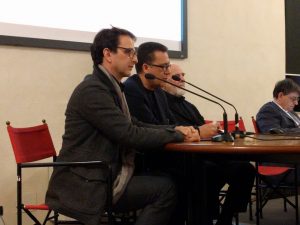
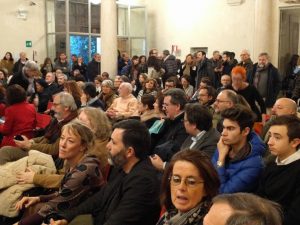
(In the first image, from the left: Paolo Naldini, Fortunato D’Amico and Michelangelo Pistoletto)
Naldini’s speech was followed by Fortunato D’Amico‘s, curator and Cittadellarte’s collaborator: “All the effort gone into organizing and setting up this exhibition has achieved great results. ‘Da Cittadellarte alla Civiltà dell’Arte’ is an exhibition highlighting the whole of the artist’s professional development and his work connected to the activities of the Rebirth embassies”. D’Amico also discussed the practice of demopraxy as carried out by Pistoletto, stating how art can open the doors to knowledge, languages and learnings as well.
The last speech, the most awaited for, was by Michelangelo Pistoletto, who started saying that art must not limit itself to being a “recreational” element of society. After illustrating to the audience the peculiarities of the Third Paradise and the trinamics, he analysed the mirror from an artistic point of view. “With my first self-portraits – a few of these works are present in the exhibition, editor’s note – I used a means that has existed through history: the mirror. It offers a live and uninterrupted depiction of the past, the present and eventually of the future. The mirror is synonym of truth, it can’t lie. My mirror paintings are not mere paintings, they represent an infinite objectivity; through these works I’ve found my identity, not only in my image, but also in the inter-individual relationship between myself and who is reflected in the mirror with me.”


(In the second image: Michelangelo Pistoletto with the mayor of Mantua Mattia Palazzi)
The occasion was also attended by the mayor of the Lombard city, Mattia Palazzi: “An exhibition of this calibre – he said – creates an international appeal for our city. It is an honour and a pleasure to present an artist who has been carrying out an extremely meaningful work for decades. In his speech, he has just stated that art is not recreational, but a commitment and a necessity to facilitate a reconnection between daily life and mankind’s horizons. Pistoletto realizes this process in an extraordinary venue like the Ducal Palace, and he does that giving it a new meaning and placing it into dialogue with the rooms of the building. Visitors will receive many inputs from this exhibition”.
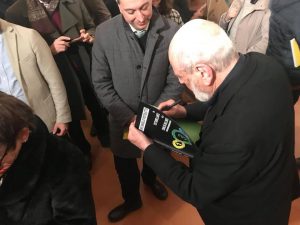
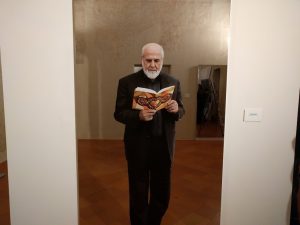
(In the second image: Self-portrait with Third Paradise Notebook, 2017 – silkscreen on super mirror stainless steel)
Pistoletto didn’t shy from an open dialogue with the public: as said, after the opening conference the participants had the opportunity to see the exhibition, a visit enhanced by the presence of the artist himself. He engaged with the guests to talk about art or simply to pose for pictures and sign copies of the (bilingual) catalogue of the exhibition (for sale at the store of the Palace). The event came to an end with a buffet in a meaningful location: the Cortile della Cavallerizza, currently housing an installation representing the Third Paradise, realized with coloured terracotta tiles symbolizing the UN 17 Sustainable Development Goals.
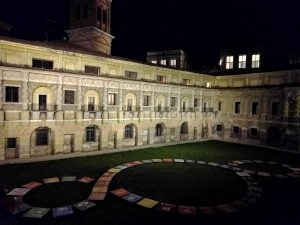

At the opening conference, speeches were also given by Massimiliano Ghizzi from Tea (sponsor) and Renata Casarin (vice-director of the Ducal Palace Museum Complex).
The exhibition was conceived on an initiative by Moz- Art (Contemporary Art) and realized with the collaboration of the Ducal Palace Society and the support of Fondazione Banca Agricola Mantovana, Fondazione Comunità Mantovana, Fondazione Bpa, Gruppo Tea and the City of Mantua. The project was also made possible by the contribution of the main partner “Mantova Outlet Village”.

